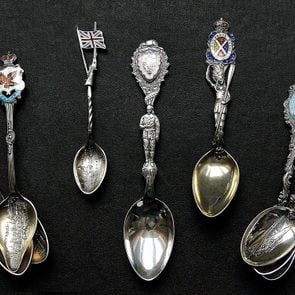Why you should floss every day
It doesn’t take a tremendous amount of time out of one’s day, but for some reason, many people aren’t flossing as they should. In fact, according to a 2018 Canadian Community Health Survey, less than half (43 percent) of Canadians aged 12 or older reported flossing their teeth at least once per day.
Flossing, the act of using thin dental string to remove food and plaque from in between your teeth, is essential in the fight against plaque build-up, tooth decay and gum disease.
For their part, manufacturers of oral health products are eager to assist the public in making flossing easier and more accessible than ever. Long gone are the days when your only flossing option was a spool of filament. Today you have an abundance of options, from floss picks to water flossers, and they come in all colours, shapes and sizes.
“There is no replacement for flossing as no toothbrush is fully effective in cleaning the bacteria-prone crevices between teeth,” says New York-based Greg Gelfand, DDS. “Ideally, you should floss after every meal, but realistically, flossing at least once a day, especially before bed is helpful for maintaining good oral health.”
But which of these options is the go-to for dentists? In many cases, it’s a matter of personal preference, but the doctors we spoke with have clear opinions on the subject.
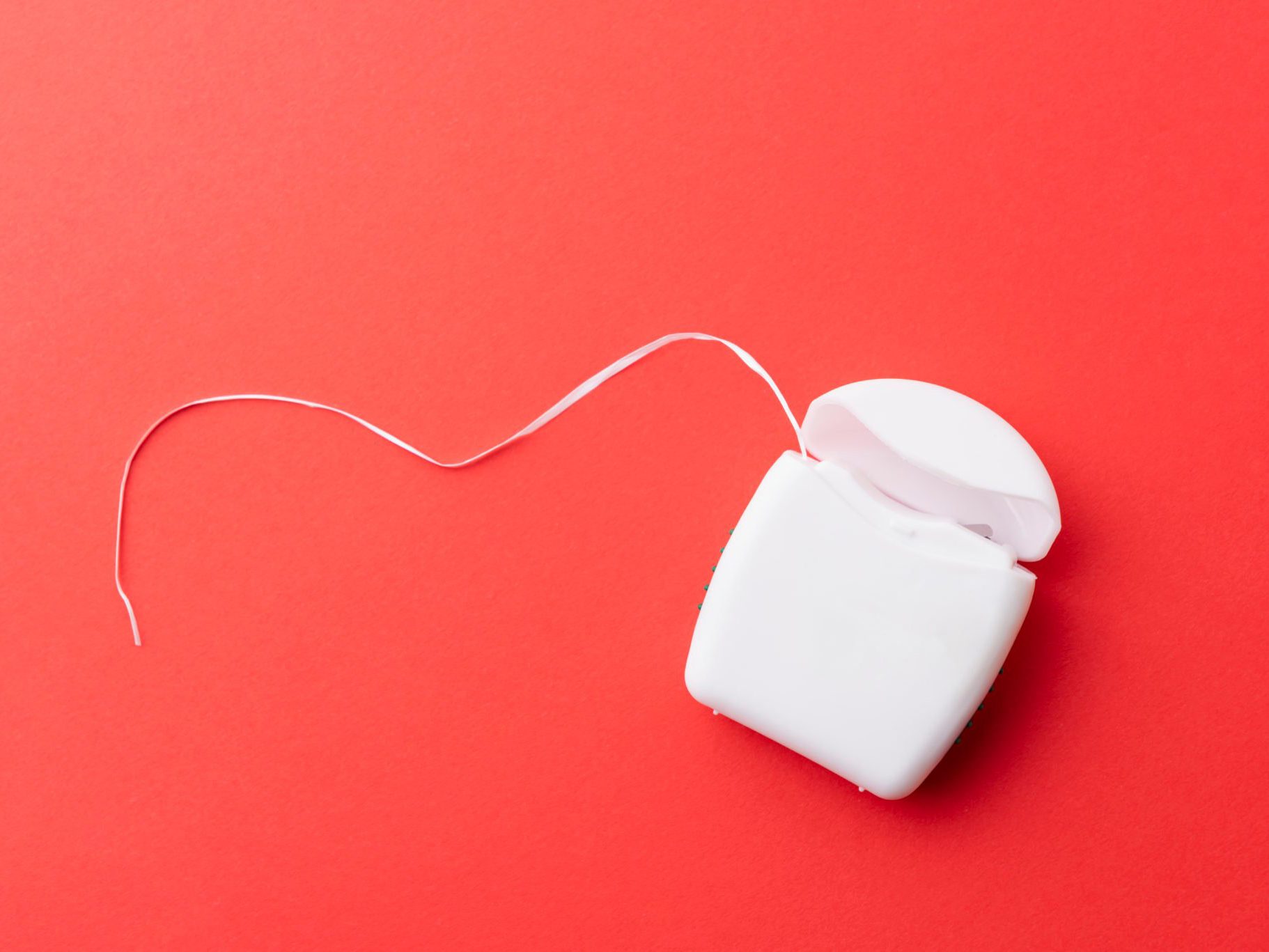
Spool of floss
When it was first introduced back in the 1800s, floss was formed by twisting silk fibres to make a long strand, according to the American Dental Association. Now, however, it’s typically made from either nylon filaments or plastic monofilaments.
Despite being as close to the “original” product as we have in 2020, dentists aren’t in love with this flossing option compared with newer types.
“I always say, the best flossing tool is the one you will use. From a question of ‘effectiveness,’ they are all comparably effective,” says Chad Evans, DDS, whose practice serves families from Dallas/Fort Worth to West Texas. “I encourage patients to find the tool that works best for them, and go with that.”
Still, he finds the traditional string both the least convenient form of flossing and most time consuming, but it isn’t without its benefits. “It does give you a fresh spot of floss for every proximal space,” says Dr. Evans. “That allows you to use a fresh and clean piece of floss between every tooth.” (Check out these clever uses for dental floss that go beyond the bathroom.)
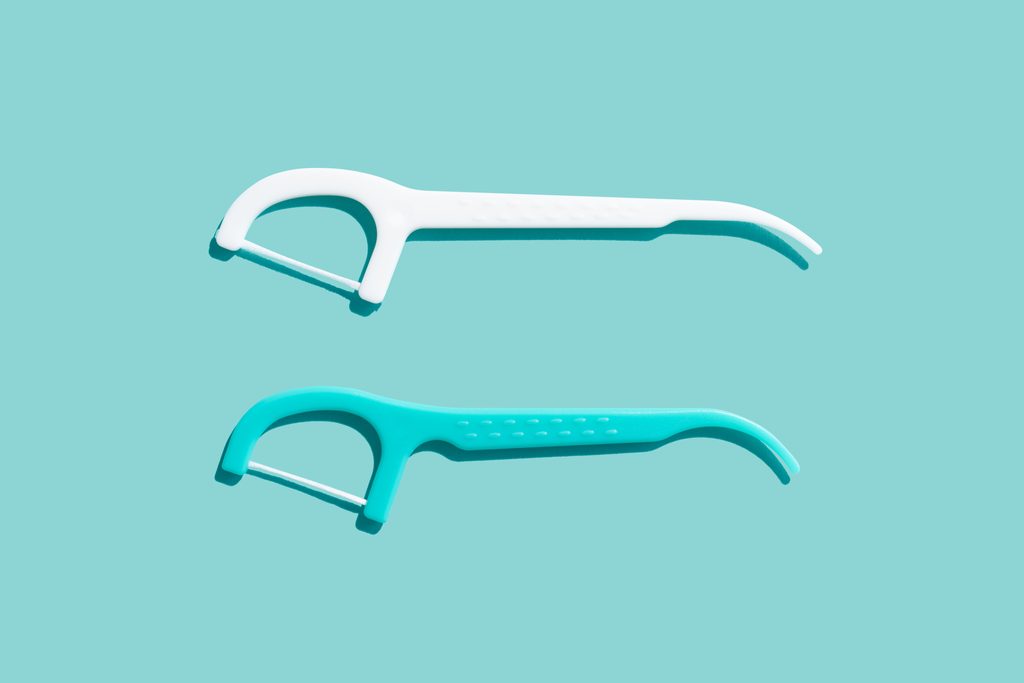
Floss pick
Across the board, the dentists we spoke with all speak highly of the floss pick. It’s often a favourite because of its convenience, quick use and effectiveness in removing debris between teeth.
Floss picks are easy-to-hold plastic implements that have a piece of pre-installed dental floss. Typically the other end is shaped at a point to be used like a toothpick to remove larger pieces of food from between the teeth.
Because these are single-use flossers, they’re easy to keep in a purse, the car, a gym bag or anywhere else you might need to floss on the fly.
“The negative is that you are using the same small piece of floss to clean in between every tooth,” says Dr. Evans. “That may decrease the effectiveness as the floss become covered with debris or bacteria.” (Check out the everyday mistakes that are ruining your teeth.)
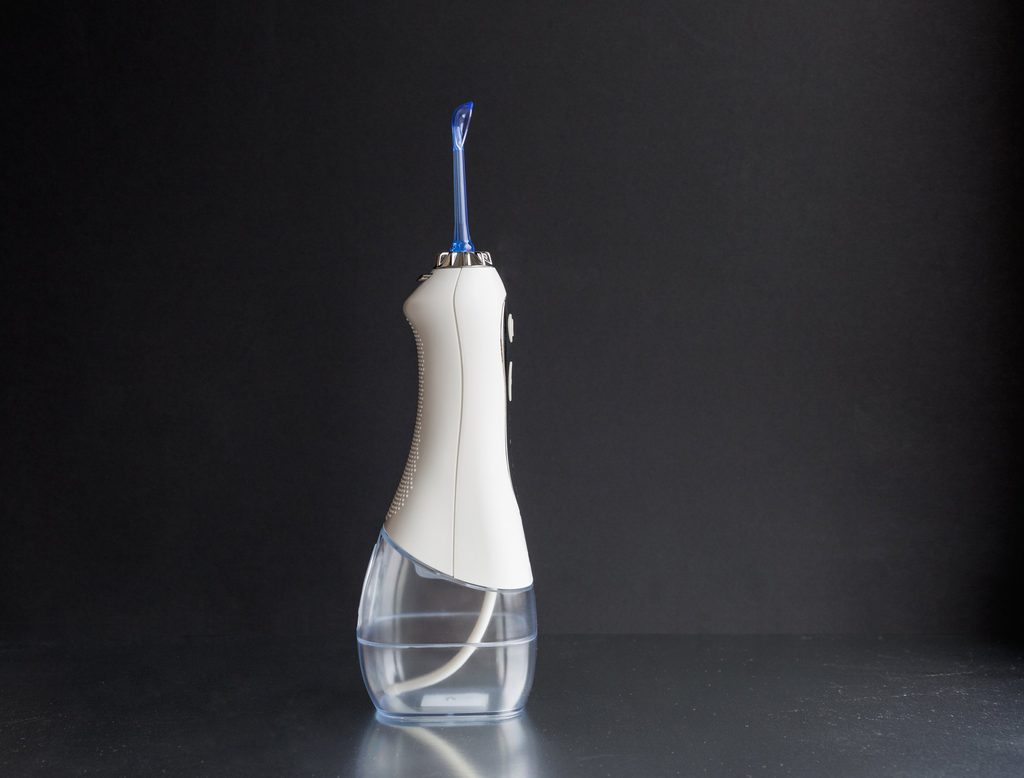
Water flosser
If you’re the type of person who likes the sleekness of tech gadgetry, then a water flosser could be the most appealing. “The water pick allows you to fill the reservoir with water or your choice of mouthwash,” says Dr. Evans. “I encourage patients to use a fluoride mouthwash in the water pick reservoir, essentially allowing them to spray fluoride into the proximal spaces between teeth.
He explains that this area doesn’t typically get much fluoride when you only brush, making it prone to decay. “The only drawback is that the water stream may not be strong enough to remove all proximal debris every time,” he says. (Watch out for these signs of disease that your teeth can reveal.)
Kid-friendly dental flossing
If you’re a parent who is trying to convince their child that actual flossing isn’t a dance, but an important part of their oral hygiene, providing the most kid-friendly tool is important.
Elliott Maser, DDS, clinical associate professor of pediatric dentistry at the University of Pennsylvania, likes an instrument called FlossAid for his young patients once they reach a certain level of hand coordination.
“The aid looks like a small plastic ‘slingshot’ that will allow floss to be wrapped around the top, and then the child uses the handle section to guide the floss through various sections of the mouth,” he explains.
Dr. Maser likes this option because its made of lightweight plastic and you can remove the floss between brushing to replace with new floss.
“The slingshot area of the floss is not so wide that a child cannot get the aid into their mouth, but adult supervision is required at younger ages to make sure the child is flossing the entire mouth, not just the easily reached areas,” he says. (Here are more secrets Canadian dentists want you to know.)
The takeaway
Ultimately, it really doesn’t matter which of these tools you use to floss as long as you do it. And remember that the most important part is getting your teeth clean, not simply going through the motions to check one more thing off of your to-do list.
In fact, Dr. Gelfand says he can immediately tell if a patient flosses or not, that’s how much of an impact it has on your oral health.
“The flossing method you are most comfortable with is the one you are more likely to commit to, so there is no gold standard for flossing tools,” he says. “I often recommend GUM Soft-Picks as an alternative to traditional floss. They are fool-proof, easy-to-use, and importantly, gentle on gums.”
Next, read about the teeth-cleaning mistakes that make dentists cringe.
In the state of the world right now, it’s likely that you have a number of things keeping you up at night. Maybe you’re up worrying about what school starting up again might look like, or maybe you’re thinking about what a post-pandemic life could look like. Whatever has you stressing, it’s likely not why “w” is pronounced like double-u and not double-v. But maybe you’re like me, and once you notice it, it haunts your waking hours. Or, also like me, you need something of a distraction right now to keep your brain sharp during quarantine. No judgment here—just answers.
History of the “w” sound
To answer this question, we have to go farther back than you may think. The two-fold answer also has two facets: the sound (pronunciation) and the visual (typeface).
As the 23rd letter of the alphabet, “w” has been around in some form long before many give it credit. Stemming from Old English, we know that the concept of the “w” sound and letter ran into problems when being converted into the ancient Roman alphabet. This Latin alphabet was then forced to come up with a symbol to represent the sound of the “w.” According to GrammarPhobia, this 7th-century problem was remedied by the symbol “uu,” which is quite literally a double-u.
Next, in the 8th century, the “uu” symbol was replaced with the “wynn” symbol (ƿ) from the Runic alphabet that was used in Old and Middle English. Later, into the 11th and 12th centuries, scribes used the “uu” symbol in its joined form, which carried into the “w” form we recognize today. There is still some evidence of the overlap between “u” and “w,” seen in similar pronunciations between the two. Lexico.com lists flower/flour, guard/ward and suede/Swede as prime examples. (Speaking of letters, learn why the letters on a computer keyboard aren’t in alphabetical order.)
History of the “w” shape
The reason “w” is written like a double-v is somewhat perplexing and phonetically confusing. Historically speaking, it would make more sense to have the “w” look more like a double-u, with curves. So why is the type-face and script so sharp and distinctly double-v looking?
The answer lies in the advent of the printing press in the 15th century. Originally, it was a single double-u block or even two “v’s” if they didn’t have the less commonly used “w” block. Then, as the technology continued to progress and became more streamlined, it was replaced with a double-v block. This is why the “w” that we know and love today looks like a double-v, despite being pronounced double-u. (These are the hardest words to spell in the English language—can you get them all?)
Evolution of the “w”
The “w” we know and love in print is very clearly made up of a double-v. In cursive, however, or certain fonts and handwriting samples, the “w” is much more like the phonetic double-u. Whatever your preference, “w” is a strange letter with an interesting past.
Next, discover these spelling and grammar mistakes that spell check won’t catch.
A storm by any other name…is just a storm? Yes, a hurricane is the same as a typhoon, which is also the same as a cyclone. The only difference is in their names, though those names do depend on where a storm originates. A “hurricane” occurs over the North Atlantic or over the central or eastern North Pacific oceans—in places like Florida, the Caribbean, Texas and Hawaii. Forming over the western North Pacific, in East Asian countries like Japan and Korea? That’s a “typhoon.” Both hurricanes and typhoons are tropical cyclones—and “cyclone” is what they’re called when they occur in other places, such as over the Indian Ocean.
Exactly what is a tropical cyclone?
Well, it starts out over tropical or semitropical waters as what the National Oceanic and Atmospheric Administration calls a “rotating” and “organized” series of clouds and thunderstorms. (In the Northern hemisphere they all spin counterclockwise.) When it first gets going, it’s called a “tropical depression.” As it picks up speed, it gets upgraded to a “tropical storm”—it needs to have winds of at least 62 kilometres an hour (39 miles an hour) to earn this designation. And when sustained winds of 119 kilometres an hour (74 miles an hour) are reached, the storm has intensified, or “matured,” to the point where we now refer to it as a hurricane, a typhoon or an intensified tropical cyclone. (Read this inspiring story of how Canadians rescued homeless dogs from Hurricane Harvey.)
Why the different names?
Cyclone is generic, and the word meteorologists use to speak generally of these storms. The Online Etymology Dictionary dates its origins to 1848 when it was presumably used first to describe an intense storm that happened over India in 1789; it comes, loosely, from the Greek word kyklon, “moving in a circle, whirling around.” The word hurricane’s origins in the Americas date to the arrival of the Spanish here in the 15th and 16th centuries; the Spanish word for hurricane is huracán. According to the Online Etymology Dictionary, the word typhoon comes from tufan, which means “big cyclonic storm” in Arabic, Persian, and Hindi. (Look out for these bizarre things that happen when it’s about to storm.)
Alike, but not always the same
Hurricane vs. typhoon, how do they compare? Well, they’re not all exactly alike; they vary in intensity and how that intensity is factored depends on who’s doing the factoring. In Canada, hurricanes are classified based on wind speed using the Saffir Simpson Hurricane Wind Scale, which is made up of five categories based on how long the wind is sustained for: Category 1 has winds of 119-153 kilometres an hour; Category 2, 154-177 km/hr; Category 3, 178-209 km/hr; Category 4, 210-249 km/hr; and Category 5, 249 km/hr and above.
However, the World Meteorological Organization gives strong typhoons, very strong typhoons, and violent typhoons a Class 5 designation, with wind speeds ranging from 119 km/hr through 191 km/hr and above. (Check out these wild photos that show the true power of Mother Nature.)
Hurricane vs. typhoon: the similarities
No matter what you call it, these potentially dangerous storms bring strong winds, lots of rain and flooding. And no matter where in the world you are, if you live in a region that experiences cyclones (or hurricanes or typhoons), the largest and most intense of those storms are becoming more and more likely, due to climate change, a recent study found.
Next, find out what not to do when severe weather strikes.
Sources:
- Canadian Hurricane Centre
- National Oceanic and Atmospheric Administration: “What is the difference between a hurricane and a typhoon?”
- Proceedings of the National Academy of Sciences: “Global increase in major tropical cyclone exceedance probability over the past four decades”
With the advent of the anti-lock braking system (ABS) that automatically “pumps” the brakes during a panic stop or normal stopping on slippery roads, brake lock-up has been virtually eliminated. First offered as an option in the 1970s, ABS has been a standard feature on virtually all new cars built since the early 2010s.
Still, brakes may still lock up occasionally, significantly increasing stopping distance and greatly reducing directional stability. That’s a problem. Here’s what you need to know about brakes locking up on vehicles with or without ABS. Check your owner’s manual or the instrument panel for the yellow ABS indicator light to determine if your vehicle has ABS. (How well do you know your instrument panel? Take our car dashboard light quiz to find out.)

Causes for Brake Lock-Up
Road Conditions
On vehicles without ABS, loss of traction between the tire tread and road surface when stopping on wet or slippery roads causes brake lock-up. Even though you’re pushing on the brake pedal as hard as possible, and your tires are no longer spinning, your tires keep skidding on the slick surface. This happens because the tires have nothing to grip onto to develop the traction needed to stop.
For maximum stopping power on slick surfaces, ABS pumps the brakes for you. This allows your tires to almost, but not quite, skid. (Here’s more expert advice on driving in wet weather.)
Mechanical Failures
On standard and ABS-equipped vehicles, minor issues such as worn brake pads, excess rust on the rotors (from your vehicle sitting for months) and installing brake pads on one axel that may heat up slower than the pads on the other axel can cause brake lock-up during normal driving conditions. Replacing worn pads (a DIY task) and normal driving should wear away anything but extreme rust build-up. Once the brake pads heat up, you shouldn’t experience any braking problems.
Let’s look at other reasons brakes lock up when they shouldn’t.
Brake Calipers
Non-ABS and ABS: Worn, missing, rusted or broken mounting hardware can cause disc brake calipers to bind, overheating the brake pads and rotors. Overheating leads to premature pad and rotor wear and brake lock-up that can cause your car to pull sharply to one side when stopping. Replacing pads and rotors can be a DIY project.
Hydraulic System
Non-ABS and ABS: A low brake fluid level, using the incorrect brake fluid, or brake friction material saturated with brake fluid from a leaking component can cause brake lock-up. (Here’s how to change your own brake fluid.) A collapsed brake hose trapping fluid in the caliper will behave the same as a binding caliper. A bad brake system proportional valve delivering equal fluid pressure to the entire brake system can cause the rear wheels to lock-up during heavy braking.
ABS only: Brake fluid contaminated from moisture can damage the ABS pump. A failed ABS pump will cause poor braking performance as well as brake lock-up. Never drive a car if you suspect a brake fluid leak.
Wheel Speed Sensors and Wheel Bearings
ABS only: Wheel speed sensors measure a wheel’s speed via a ring gear on the wheel hub bearing and sends that information to the car’s Engine Control Module (ECM). A worn wheel hub bearing, damaged ring gear or failing speed sensor sending inaccurate data to the ECM may engage the ABS for no apparent reason when stopping, locking up the brakes.
Check your tire pressure. A tire with low pressure will roll at a different speed than the other tires, sending faulty data to the ECM.
ABS Computer
This encompasses the ABS controller/module and or ABS pump and is the ‘brains” of the system. A malfunctioning ABS computer can cause exactly what ABS tries to prevent—locked-up brakes. A problem with the ABS computer or electronics will cause poor braking performance. It will also activate the ABS dash warning lamp, letting you know it’s time to visit your mechanic. (Here’s why you should never ignore your car’s check engine light.)
Driver Reaction to Road Conditions
If your brakes lock up while stopping, remain calm!
On non-ABS vehicles, pumping the brake pedal will help the tires maintain traction if the brakes lock up due to a mechanical issue or if skidding on slippery roads.
On ABS-equipped vehicles, holding your foot firmly on the brake pedal should automatically activate the ABS when the computer senses a skid condition. In addition, pressing down hard on the brake pedal may activate the ABS if the system isn’t working properly. Conversely, never pump ABS brakes. This is a sure way to confuse the computer, making it more difficult to stop and steer your vehicle. The ABS is designed to alert you if there are any problems with the system.
Now that you know what to do when your brakes lock up, find out 100 car maintenance jobs you can do on your own.
At the end of the day, you may notice some symptoms like numbness, tingling and weakness in your hands and wrists. This may ring especially true if you spend hours typing on your keyboard, holding your phone as you scroll through social media or even playing an instrument.
It turns out these painful sensations, which are a type of repetitive strain injury, are commonly experienced in many lines of work, and they’re also key traits of carpal tunnel syndrome.
What is carpal tunnel syndrome?
Carpal tunnel syndrome is the name for a collection of symptoms that happen when a major nerve in your hand is squeezed as it travels through your wrist.
The “carpal tunnel” is a small passageway of ligament and bones at the base of your hand that protects the median nerve and tendons that go to your fingers. The median nerve provides feeling to your thumb, index, middle and part of the ring finger (although not the little finger).
It also controls some small muscles at the base of the thumb.
“Imagine the nerve is a hose running through your wrist, carrying energy to your hand and fingers. Now imagine that hose gets a kink in it from being bent repeatedly. That’s how carpal tunnel syndrome starts,” says Eileen Meehan, an occupational therapist and certified hand therapist and an assistant professor of occupational therapy at Touro’s School of Health Sciences in New York City.
“The more the hose gets kinked or the longer the kink stays, the less energy gets through and the more symptoms you experience,” she says. “If you don’t fix the kink in the hose, it can become permanently damaged.”
It doesn’t take much to “kink” the nerve—any time you flex your wrist past 20 degrees you are pinching the carpal tunnel that the nerve runs through, says David Clark Hay, MD, an orthopedic hand and wrist surgeon at Cedars-Sinai Kerlan-Jobe Institute in Los Angeles. (Read about the story of this woman who suffered excruciating pain in her hands for a decade before doctors finally found the cause.)
Carpal tunnel syndrome symptoms
The signs and symptoms of carpal tunnel syndrome can be very subtle at first but it’s important to recognize them immediately. If you can catch the problem early, you have a better chance of reversing or even healing it, Dr. Hay says.
Typical symptoms start with numbness, tingling, and/or pain in your fingers, hand and wrist. “Many patients describe it as a feeling of electricity or ‘shocks’,” Meehan says.
As the syndrome worsens, you may experience more severe pain and weakness in your hand and have trouble pinching your thumb to your fingers, Dr. Hay says.
There are three stages of carpal tunnel syndrome, based on the severity and type of your symptoms, Dr. Hay says.
-
Stage 1: You have intermittent symptoms that may only occur when doing certain activities or when waking in the morning.
-
Stage 2: You feel consistent symptoms on and off during the day and the pain may be severe enough to wake you at night, which is evidence of a mild nerve injury.
-
Stage 3: Your symptoms are always present and in addition, you experience weakness or muscle loss in your thumb, which is evidence of nerve compression.
Carpal tunnel syndrome causes
There are two general causes of carpal tunnel syndrome: The improper positioning of your wrists and the overuse of your hand muscles, Meehan says. It’s often known as a computer problem because it can happen if you are typing and using a mouse for hours at a time. However, carpal tunnel can occur as the result of many different types of activities, she says.
Other common ones include scrolling on a tablet, playing an instrument, using equipment that vibrates (like a jackhammer, vacuum, or lawn equipment), or holding your phone. (Did you know some repetitive motions can also cause eye strain?)
“The most important thing is to figure out which particular activities are the ones causing you pain and those may differ from person to person,” Meehan says. “Once you understand the physiology of what’s happening in your wrist and which activities trigger it, then you can fix it.”
You should also be aware that while all carpal tunnel cases involve hand symptoms, not all hand or wrist issues are caused by carpal tunnel syndrome, says Daniel Curtis, an orthopedic physical therapist and certified manual therapist with Orlando Health in Florida.
“Hand pain, tingling, and numbness may also be caused by elbow, shoulder, neck or back problems so it’s very important to understand the real underlying problem as the treatments will be different from carpal tunnel treatment,” he explains.
Risk factors for carpal tunnel syndrome
While all carpal tunnel syndrome cases come from the same two causes, not all people are equally affected, says Kanu Goyal, MD, an orthopedic hand surgeon at The Ohio State University Wexner Medical Center. Gender plays a role, with three times as many women as men getting carpal tunnel syndrome.
Age is also a risk factor. The older you get, the more wear and tear happens on your wrists and hands, and the more likely you are to experience overuse injuries, Meehan says.
People with certain illnesses or health conditions, like diabetes, obesity, pregnancy and hypothyroidism, are at an increased risk of carpal tunnel syndrome, Dr. Goyal says. While you can’t control your gender or age, you can take steps to manage your overall health.
“Better management of these conditions may help prevent excessive symptoms associated with carpal tunnel syndrome,” he says.
You may also be at a higher risk if you have sustained an injury to your wrist or hand, both recent or in the past, Dr. Curtis says.
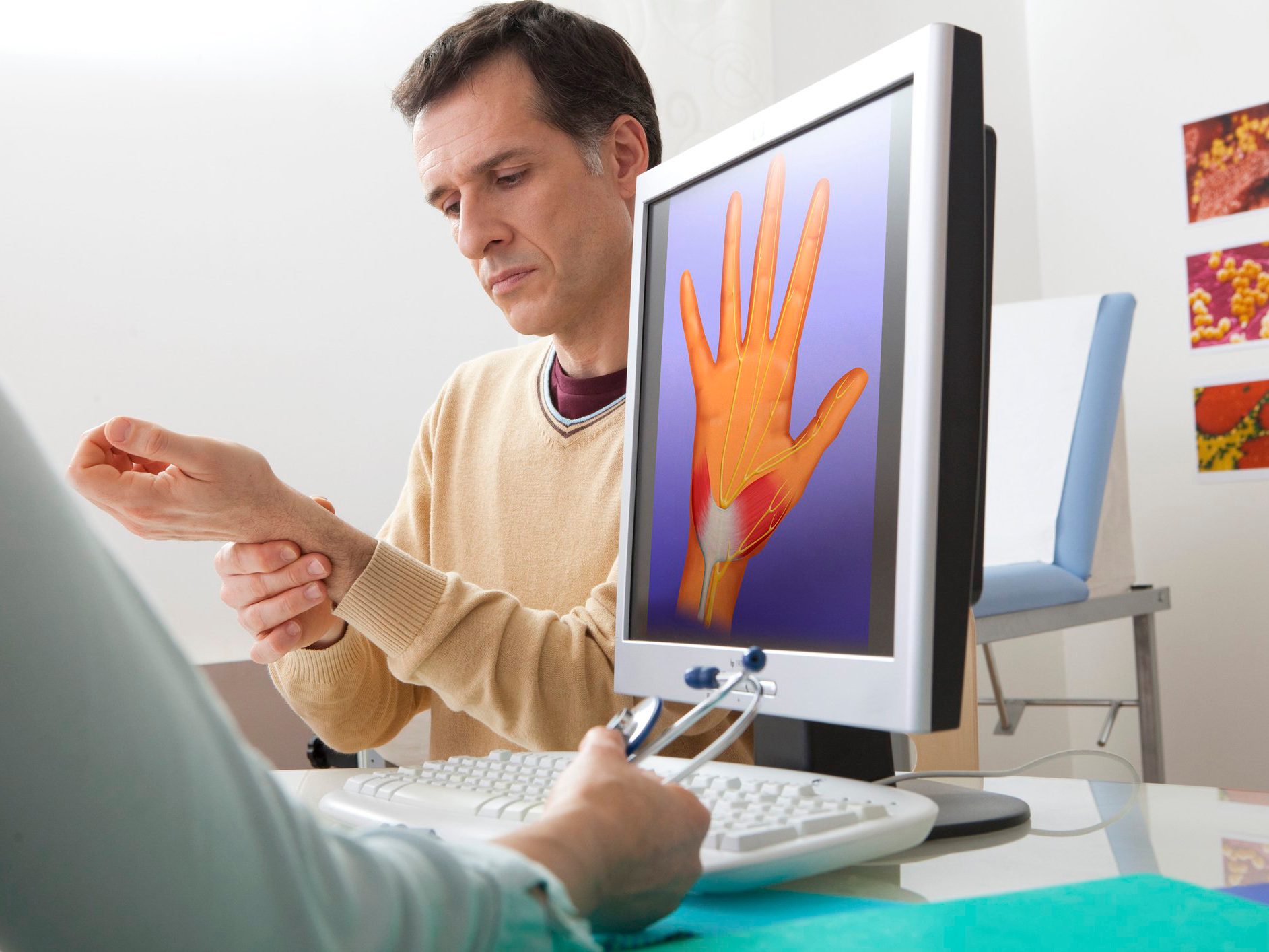
Carpal tunnel diagnosis
Diagnosing carpal tunnel syndrome is generally based on the patient’s report of their own symptoms, Dr. Hay says. Your doctor may order a nerve conduction study—a type of test that uses electrodes placed on your hand and arm to look at how your nerves and muscles react to stimulation—but this is usually only done to confirm the severity of the problem or to rule out other problems, not to diagnose it, he explains.
Your doctor will likely order other tests to rule out conditions with similar symptoms like diabetic neuropathy (nerve damage due to elevated blood sugar), a pinched nerve in your neck, a tumour or inflammatory arthritis.
“The diagnosis is really about listening to the patient about what types of symptoms they have, how often they’re occurring and how much it’s impacting their ability to live their life,” he says. “From there we can make a treatment plan.”
A diagnosis will likely also include a manual exam where your doctor or a physical therapist has you go through a range of motions and positions to see if they can find what provokes the symptoms, Dr. Curtis says. For instance, a common physical test is to bring your arms in front of your body, fingers pointed down and then press the backs of your hands together for one minute.
“These special tests can help us determine if the problem is really due to compression of the nerve in the wrist or if it is caused by something higher up the chain, like a neck injury,” he says.
Body awareness is an important component for getting an accurate diagnosis, Meehan says.
“Too many people think wrist or hand pain isn’t a big deal and will try to ignore it. You need to pay attention to what exactly is causing you pain, how long the pain lasts and where it is occurring, even if it seems slight,” she says. “This is all information your medical team needs to help you.”
Carpal tunnel treatments
Treatment for carpal tunnel syndrome depends on the severity of the condition. Mild symptoms can typically be managed with home remedies while surgery may be an option for those who have severe median nerve damage.
It’s important to discuss with your healthcare provider to weigh what options are best for you and your lifestyle.
Home treatments
Home treatments for carpal tunnel syndrome fall into two main categories: Changing your habits to reduce whatever is causing the pain and supporting your wrist while it heals, Dr. Goyal says.
“Carpal tunnel syndrome, in my opinion, can first be best managed with proper ergonomics during activities of daily living,” he says. “Specifically it is best to avoid excessive and prolonged positions of wrist flexion or extension.”
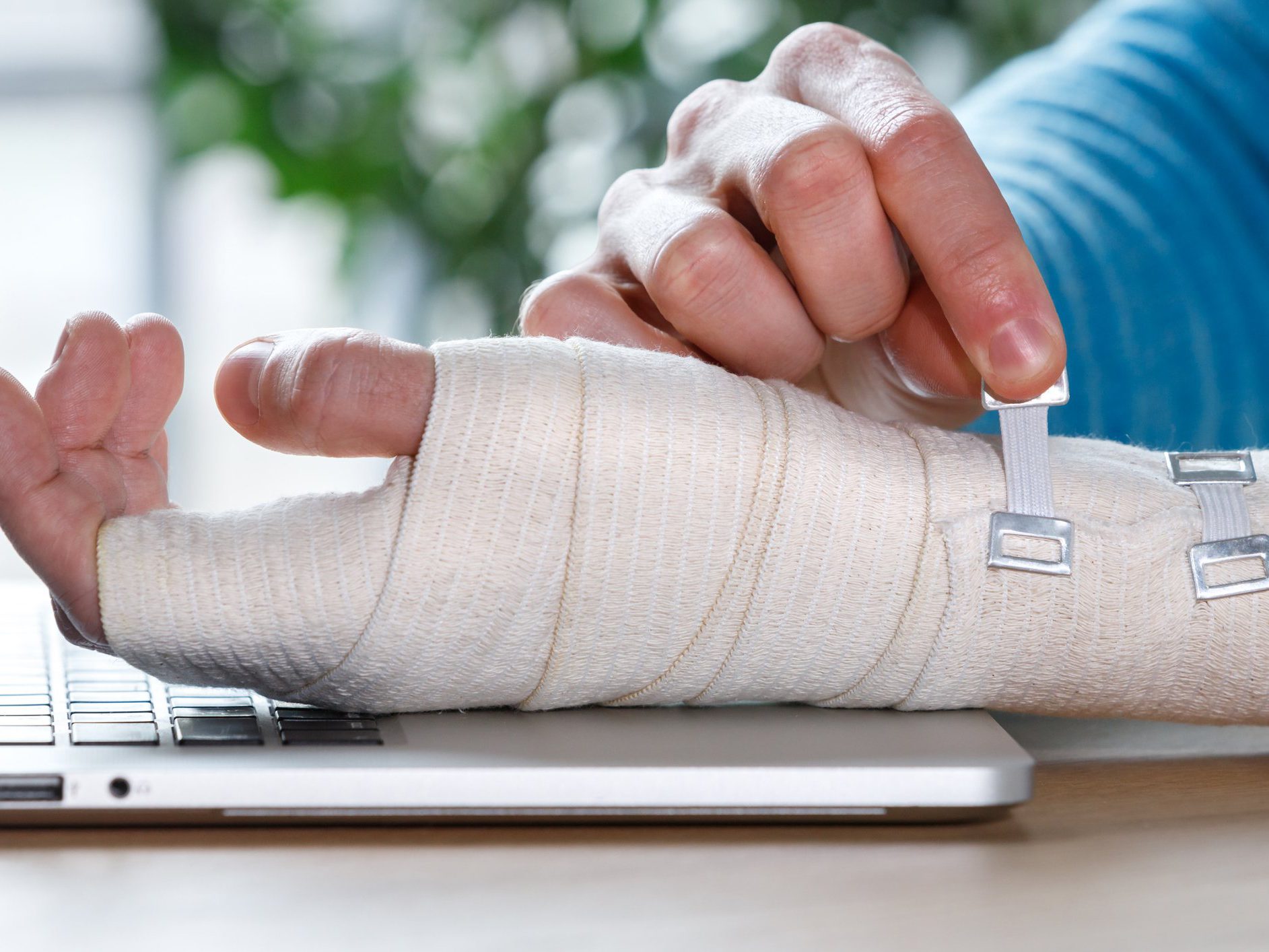
Wear a wrist brace
One of the most important things you can do to help your carpal tunnel syndrome is to start wearing a wrist splint or brace to keep your hand and wrist in a neutral position, Dr. Goyal says.
“Often, patients will have excessive symptoms at night so I recommend sleeping with the splint on,” he says. “Wrist splints may also be worn during the day as well as needed during activities that cause the symptoms.”
For the best results, Meehan recommends having a custom brace made to fit your arm but you can also buy a wrist brace online or in just about any pharmacy and still get good results, she says.
Change your habits
Our society wants quick fixes but if you want to truly heal your carpal tunnel syndrome you need to change your daily habits that are contributing to your problem, Dr. Curtis says. So if you have a job that requires a lot of hand use then you need to find ways to use your hands less at home and when doing your hobbies.
This may mean finding a different way to hold your steering wheel, limiting your time playing video games, sleeping in a different position, holding your child in a different way, learning a new way to hold a knife when chopping food or using electric instead of manual tools for home projects.
“This is often the hardest part for patients but it will give you the best long-term results,” he says.
Ergonomic equipment
Once you’ve identified the cause of your carpal tunnel symptoms, it’s incredibly important to take steps to fix your physical environment, Meehan says.
For instance, if your pain comes from typing for hours on your laptop, it may be helpful to invest in a desk and chair that allow you to position your arms at a better angle or a computer mouse that gives your wrist a break.
An occupational therapist can help you identify your trouble spots and come up with solutions for your particular issues.
Use assistive tools
Another way to reduce the compression on your nerves and allow them to heal is to look for workarounds for common hand-intensive activities, Meehan says.
So for people who have pain when using their phone, they could buy a ring grip that allows them to hold the phone without bending their wrist, use the voice-to-text option instead of typing with their fingers and use a stylus instead of a finger for scrolling.
Take frequent breaks
In an ideal world, you’d be able to simply stop whatever repetitive motion is causing your pain but for many people, it’s an integral part of their job.
One way to help manage this issue is to take frequent “wrist rest” breaks, Dr. Curtis says. Set a timer on your phone every hour to remind yourself to stop what you’re doing or change activities.
Ibuprofen
Part of what causes the problem is inflammation so taking a non-steroidal anti-inflammatory medication, like ibuprofen (Advil), can help manage your symptoms and reduce the pain from carpal tunnel syndrome, Dr. Hay says.
Note that this does not fix the underlying problems of poor wrist position or hand overuse so it’s not an effective treatment on its own, he adds. If you find yourself needing to take pain medication regularly it’s time to talk to your doctor about different treatment options.
Don’t push through pain
“Carpal tunnel syndrome is very treatable if we catch it in the early stages but it can do permanent damage if you let it go too long,” Dr. Hay says.
Pain is your body’s signal that something is wrong so don’t try to push through it and be honest with your doctor about the severity of your symptoms, he adds.
Gentle stretches
There aren’t any exercises to help carpal tunnel syndrome because the problem is that you’re already using your hand too much—adding exercises on top of your daily activities can make the problem worse, Meehan says.
However, taking breaks several times a day to gently stretch out your hands and wrists can be beneficial and provide some pain relief, particularly if you are wearing braces, she says. You might consider starting with these carpal tunnel stretches from Alberta Health Services.
Maintain a healthy weight
“Obesity and weight-related disorders have been linked to carpal tunnel syndrome and therefore keeping your weight under control may help prevent and reduce symptoms from carpal tunnel syndrome,” Dr. Goyal says. (Make sure to incorporate these anti-inflammatory foods that reduce pain.)
Medical treatments
Surgery
Surgery is the only way to correct a severe case of carpal tunnel syndrome, Dr. Hay says. “Once you’re in stage three, there’s physical damage to your nerves and muscles that needs to be physically corrected through surgery,” he explains.
“Surgery allows us to take the pressure off the nerve and by taking the pressure off the nerve, we stop the damage that is occurring to the nerve and allow the nerve to recover,” Dr. Goyal says.
Don’t let the idea of surgery scare you. “The good news is that carpal tunnel surgery these days is minimally invasive, has a quick recovery, and is usually successful,” Dr. Hay says. “Ninety-five percent of patients get at least 95 percent relief, with some seeing a total resolution of their symptoms.”
There are two types of carpal tunnel release surgery: Endoscopic surgery done through the wrist crease or an open release surgery done through an incision in the wrist. Both surgeries are similarly effective, Dr. Hay says.
“The surgery usually takes only about ten minutes, can be done with the patient awake, and only requires skin to heal, which is complete at two weeks,” Dr. Goyal says. You may have a couple of stitches and have some pain or soreness, particularly at the incision site, but you’ll be able to start using your hand within a couple of days and should be fully recovered within two to four weeks, Dr. Hay says.
Steroid injections
If you’d like to try a less invasive option than surgery but need more relief than home treatments provide, a steroid/cortisone injection into the carpal tunnel can be an effective treatment for patients who have mild or moderate symptoms that are intermittent in nature and have been present for less than a year, Dr. Goyal says.
Additional resources
Carpal tunnel syndrome can be troublesome to deal with, especially if your occupation requires repetitive motions with your hand and wrist. However, lifestyle changes can help alleviate numbness, tingling, and weakness.
If your pain is too severe, it’s best to talk with your doctor to determine the best treatment plan for your needs. For more help and information about carpal tunnel syndrome, consider the following resources:
Rosacea vs. psoriasis vs. eczema
Rosacea, eczema and psoriasis can sometimes look and feel alike. They can include itching, rashes and redness, which are common symptoms of chronic inflammatory skin conditions.
It’s not always clear what causes them and there is no cure for any of them—although they can go into remission, meaning symptoms disappear for a while but may come back. So, how do you know which one you have?
The differences between each condition go more than skin deep—in terms of specific symptoms, treatment, triggers, and how they impact the overall health of the body.
Here’s a guide to help you identify the differences between skin conditions like rosacea, eczema and psoriasis.
Rosacea
Rosacea is a chronic condition that mainly targets the face that presents as flushing or redness of the cheeks, nose, forehead and chin. More than 3 million Canadians have rosacea, according to the Canadian Dermatology Association.
The cause of rosacea is unknown, but people who blush or flush easily, have fair skin and are of European descent seem to be more prone to rosacea.
Over time, the flushing becomes ruddier and appears more often with visible blood vessels. It is typically seen in men and women after 30, yet women are diagnosed with rosacea more often. This could be because women seek treatment more than men, says Pooja Sodha, MD, FAAD, director of cosmetic dermatology at George Washington Medical Faculty Associates, in Washington, D.C.
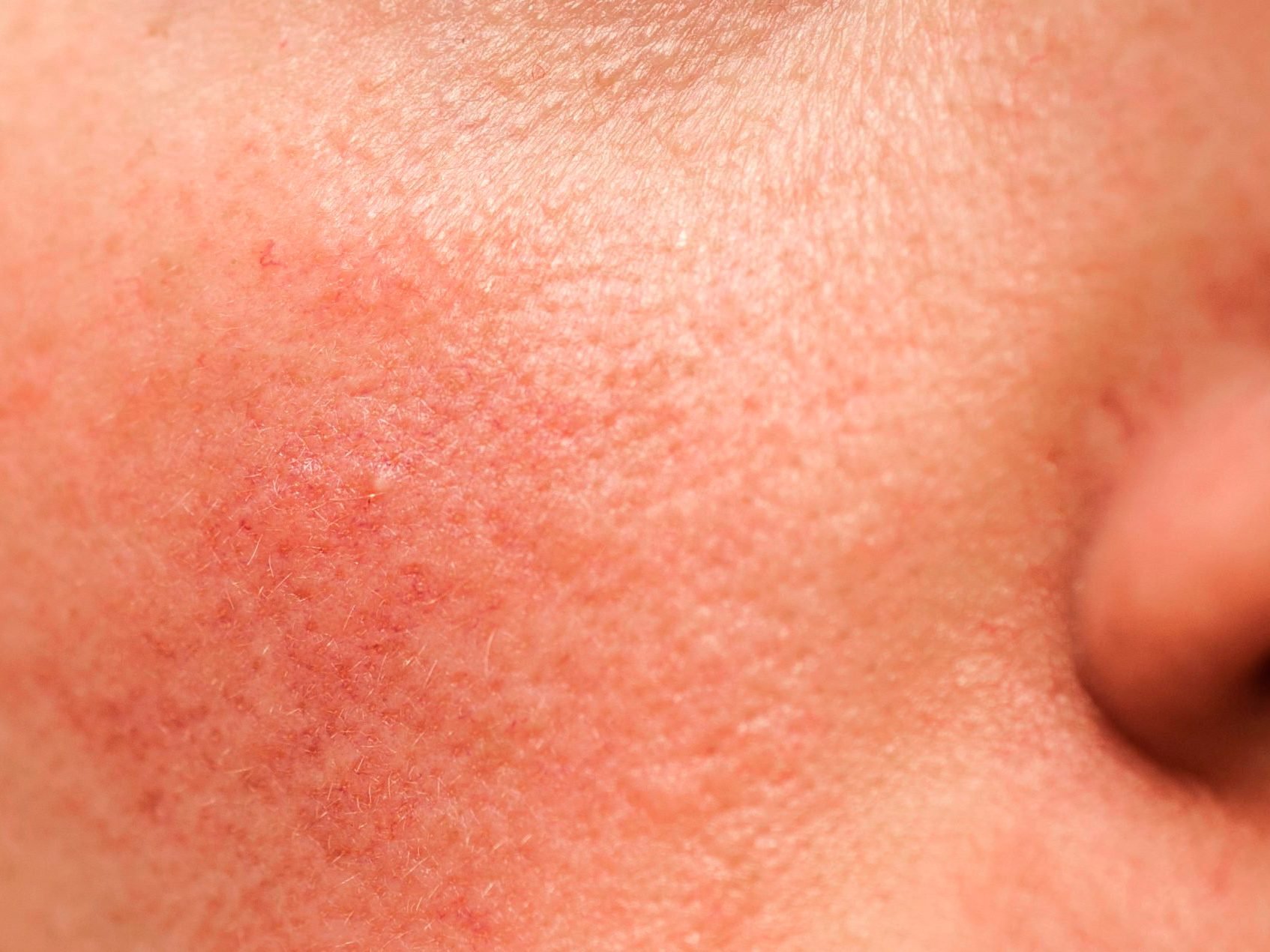 Symptoms of rosacea
Symptoms of rosacea
Symptoms and their severity vary by individual, but typically, symptoms worsen with age, especially if the condition goes untreated. “Men, in particular, often have more severe cases, Dr. Sodha says.
“Men are more commonly afflicted with a progressive variant affecting the nose, known as phymatous rosacea,” says Dr. Sodha. That’s when the skin on the nose is thicker with irregular lumps and enlarged pores.
People with rosacea shouldn’t ignore or delay seeing their doctor if they have symptoms such as redness, irritation, bloodshot eyes or watery eyes. “Long-standing untreated symptoms increase the risk of developing eyelid scarring and progressive vision loss from corneal ulcers,” Dr. Sodha cautions.
Common symptoms include:
- Flushing or redness along the nose, cheeks, chin, and forehead that last a few minutes or is persistent
- Rough or scaly skin
- Visible, fine blood vessels
- Stinging and burning
- Itching
- Inflamed red bumps and fluid-filled bumps
- Swelling
- Redness, inflammation, and irritation of the eye and eyelid and/or watery and bloodshot eyes
- Thickening of the skin with irregular lumps and enlarged pores and pimples
Rosacea treatments
While there is no cure for rosacea, it is treatable with medications and proactive measures to control and manage rosacea flare-ups. However, there is no single definitive treatment or course of medications that fits every person who has rosacea.
“Though it is difficult to predict which treatment will be most effective until a trial of the treatment regimen has been initiated, there is an extensive arsenal of options, often aligned with the subtype of therapy,” says Dr. Sodha. “A skin care routine of a very gentle cleanser, soothing moisturizer, and sunscreen should be a part of every treatment regimen.”
Treatments include anti-inflammatory and antimicrobial ointments and pills and anti-parasite creams. The anti-parasite targets the demodex mite. (They aren’t as scary as they sound. These are mites that live on our hair follicles and are quite common, but they often cause trouble in people with rosacea.)
Retinoids may be prescribed for stubborn cases of pimples and fluid-filled bumps. For rosacea that surrounds the eyes and eyelids, Dr. Sodha recommends warm compresses, neutral baby shampoo and lubricating eye drops. Vascular laser and pulsed light treatments can minimize redness, pimples and visible blood vessels.
Finally, it might be wise to check on the status of your body’s microbiome—the collection of naturally occurring microorganisms that live in your gut and elsewhere on the body—as it affects skin health. “Research suggests that rosacea patients have a higher prevalence of small intestine bacterial overgrowth,” says Dr. Sodha.
Rosacea flare-up prevention
In addition to medical therapy, people with rosacea can stay in remission and minimize flare-ups by identifying and avoiding specific triggers. (Triggers include things like food, the weather, cosmetics, stress, illness, medication and other factors).
However, triggers can be highly individual. What causes a flare-up for one person might not have an impact on another person. It is useful to keep a diary to identify things that prompt a flare-up.
A National Rosacea Society survey of 1,066 rosacea patients found there are some rosacea triggers that are more common than others. The top five from the survey are sun exposure (81 percent), emotional stress (79 percent), hot weather (75 percent), wind (57 percent) and heavy exercise (56 percent).
Psoriasis
“Psoriasis is an immune-mediated inflammatory condition (a dysfunction of the immune system that causes inflammation in the body) that affects the skin and joints driven by environmental exposure and genetic predisposition,” says Dr. Sodha.
The Canadian Association of Psoriasis Patients reports about a million Canadians experience psoriasis, and chances are if you have psoriasis you probably have family members who have it too. “There is a tendency to see this condition manifest in families, with more than 45 percent heritability in the first and second-degree relatives,” says Dr. Sodha.
Usually, your body grows new skin cells and sheds them every 30 days. In psoriasis, the immune systems go into overdrive and produce new skin cells every three to four days. But, instead of shedding, the dead skin piles up on the skin’s surface that looks like raised reddish patches with a thick layer of the silvery-white buildup of dead skin cells that looks scaly.
What isn’t visible is the impact psoriasis has beneath the skin, including on the joints of the body. One in three people with psoriasis develop psoriatic arthritis, a disease that causes stiffness, swelling, and pain in the joints and areas surrounding the joints.
Chronic inflammation in psoriasis is associated with other serious conditions such as cardiovascular disease, type 2 diabetes, anxiety, and depression. If you have psoriasis, take action to stay ahead of these conditions by making healthy lifestyle choices and get screened for these conditions.
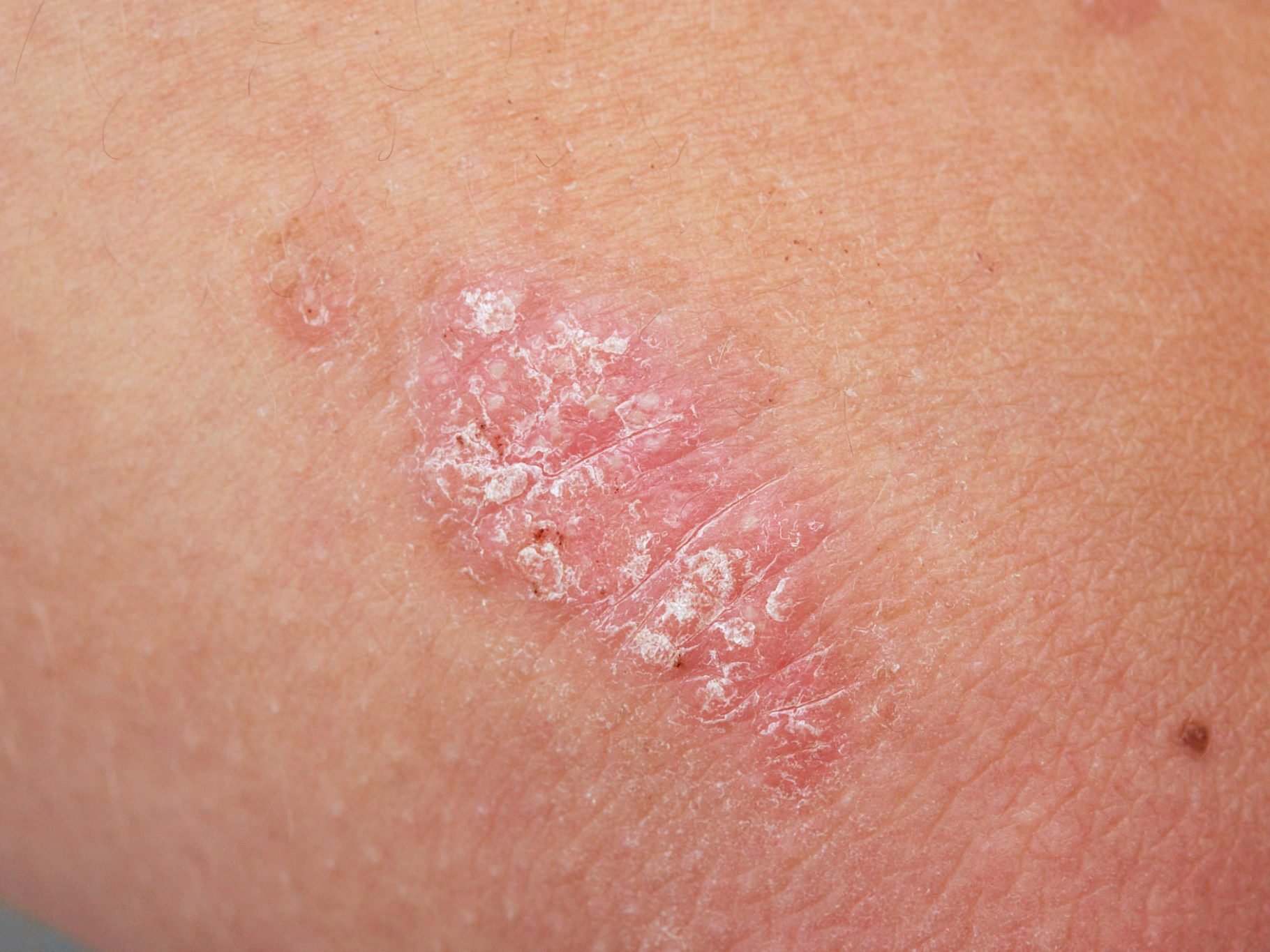
Symptoms of psoriasis
Psoriasis symptoms can happen at any stage of life, but typically they occur between the ages of 15 and 25 and affect people of all ethnicities. The most common symptom are raised reddish patches with a thick layer of silvery buildup of dead scaly skin.
Called plaques, these skin patches affect 80 to 90 percent of people with psoriasis, Dr. Sodha says. The plaques can be few or widespread, and are usually symmetric in pattern. Plaques can appear anywhere on the body, but most often on the elbows, knees, scalp, trunk and buttocks.
Other symptoms include:
- Itching, burning, and stinging skin
- Shedding skin
- Nail splitting, changes in color, and thickness of nails (Find out what it could mean if you have ridges on your nails.)
- Lesions in the skin folds, such as armpits, genitals, groin, and breast
- Pustules over the plaques, diffusing small drop-like lesions and general redness
Psoriasis flare-up prevention
As with rosacea, specific triggers can make psoriasis symptoms feel worse. “The disease can be instigated or worsened by certain medications (classically beta-blockers, lithium, and antimalarial drugs), skin trauma (sunburn, bug bites, vaccinations), infections, pregnancy and stress,” says Dr. Sodha.
Anything thing jolts your immune system can bring about a painful flare-up. That could be a cold, strep throat or even an ear infection. And it’s a good time to think about quitting smoking if you’re a smoker.
“Smoking has been shown to be increased in prevalence in those with psoriasis and increases the severity of psoriasis,” says Dr. Sodha.
Psoarisis treatments
There are a lot of options when it comes to treating psoriasis. Everyone responds differently to treatment, so relief or remission may come in the form of a combination of over-the-counter medications with prescription medications or phototherapy.
“Mild to moderate skin limited disease can be treated topically with a combination of steroids, emollients such as Vaseline mixed with salicylic acid, retinoids and vitamin D. Phototherapy treatment exposes the skin to an artificial UVB light source, according to the National Psoriasis Foundation.
When used regularly, it can slow the growth of affected skin cells. Moderate to severe psoriasis with or without arthritis typically requires systemic treatment in the form of small molecule disease-modifying drugs, such as methotrexate and systemic retinoids or biologics,” says Dr. Sodha.
Biologics are created in a lab to mimic naturally occurring proteins and molecules, and are given as an injection or IV.
Eczema
Also called atopic dermatitis, eczema is a common allergic skin disease that causes itchy skin. The exact cause of eczema is unknown, but environmental triggers and genes are known factors.
It often starts in early childhood. “Eczema is an inherited skin condition. It is often associated with asthma or allergic rhinitis (hay fever). It is very common, and it has been estimated that over 10 percent of individuals in Western countries are affected,” says Jeffrey Weinberg, MD, associate clinical professor, Mount Sinai, New York.
Exposure to things outside or inside the body, like detergents, pollens, food, and some bacteria, can prompt inflammation and cause eczema symptoms.
A 2017 study published in the Journal of Allergy and Clinical Immunology found that some people with eczema don’t have enough filaggrin, a protein creates a protective barrier on top of the skin to help keep moisture in and bacteria and viruses out.
If your filaggrin is on the fritz, it makes your skin more prone to dryness and infection. According to the American Academy of Allergy, Asthma, and Immunology, a faulty filaggrin is a culprit for moderate to severe eczema in about a third of people of North European and Eastern Asian descent.
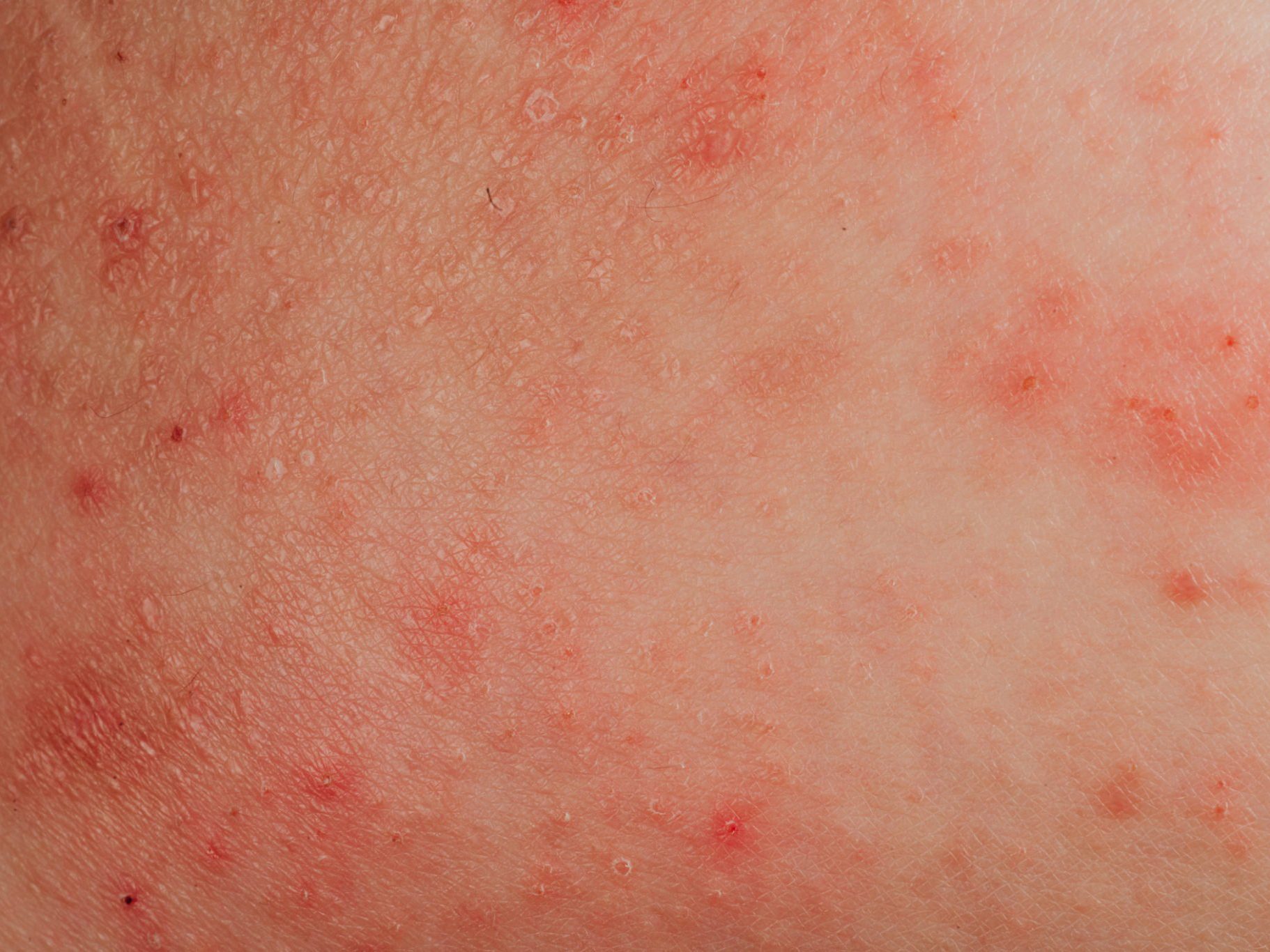
Symptoms of eczema
The main symptom is itchy skin. Where the itch is located will depend on the individual. Children tend to have eczema on their cheeks, elbows, knees and scalp. In adults eczema typically shows up in the creases of the face and neck, wrists, elbows, knees, and ankles.
Sometimes, itching is so intense, scratching it leaves the skin susceptible to infection. “Chronic eczema can be associated with impaired health as a result of systemic inflammation. People with eczema are at risk of skin infections,” says Dr. Weinberg.
Infections such as staph and herpes can be very serious, as they can spread across the body and should be treated immediately.
Other symptoms include:
- Itchy skin
- Dry skin
- Red or inflamed skin
- Chafed or scaly patches of skin
- Bleeding (from scratching)
- Swelling
- Crusted or oozing skin
Eczema flare-up prevention
What may trigger your eczema may not bother someone else at all. Dr. Weinberg says harsh soaps and environmental allergens, like dust mites, animal dander and cigarette smoke, are common eczema triggers. (Check out these tips on how to eliminate common environmental allergens.)
Be mindful of things that cause dry skin, like the cold, dry air of winter and frequent bathing without applying a high-oil content moisturizer afterward.
Be alert of possible irritants such as wool and polyester clothing, and wash new clothes before wearing them. (Remember to use fragrance-free detergent!) Fragrances, household disinfectants, and cleansers, and even the nickel found in jewellery, zippers and snaps are common triggers.
Eczema treatments
Chronic itching associated with eczema can be unbearable at times, even debilitating. The intensity can be more frustrating than a mosquito bite or poison ivy itch, except the antihistamines that work for those bites don’t help the itching that comes from eczema.
The key to battling itchy, dry skin is moisturizing frequently, says Dr. Weinberg. “Eczema is usually treated with topical medications, including topical corticosteroids and non-steroids,” says Dr. Weinberg. As with psoriasis, biologic agents and phototherapy are also used to treat eczema. Immunosuppressants help control symptoms.
Natural and alternative treatments approved by the National Eczema Foundation include sunflower seed oil, apple cider vinegar and bathing with colloidal oatmeal. It’s always good practice to discuss any treatment with your doctor before trying it. (Try eating these foods to help treat eczema.)
How skin conditions may impact mental health
Whether it’s the unrelenting itching or how you feel about the appearance of your skin—or just being mentally exhausted from managing your symptoms—rosacea, psoriasis, and eczema can really impact your mental health.
A 2015 study in Nature Reviews Immunology suggests that when there’s skin inflammation, neuro-connections let the brain know. As a result, you could feel depressed, anxious, tired, and have foggy thinking.
Managing these skin conditions can be grueling and exhausting on your body and your emotional well-being, so don’t put off asking for help.
Next, check out six more common skin conditions—and how to treat them.

Ghost Busted
It can be so darn difficult these days to know whether you’re looking at a ghost from your past, an actual ghost or a child in a ghost costume. Thankfully this howl-to guide will help you to understand whether you are literally or figuratively being haunted! Read on boo-low.
Scenario: Every time you walk along the pier, you can’t stop thinking of how she broke your heart, leaving you for that Pilates instructor.
Status: Figurative haunting
What to do next: Download some dating apps and make new connections.
Scenario: A translucent figure sits on the edge of your bed in a nightgown, staring at you in silence while an eerie light emanates from its being.
Status: Literal haunting
What to do next: Call a medium.
Scenario: You’re looking through old family photos, when suddenly you notice a pale spectre just out of frame. Its eyes bore into yours as though it sees you in real time.
Status: Just a regular human child—specifically, your aloof younger cousin whose parents were obsessed with zinc sunscreen.
What to do next: Share the photo on social media and tag your cousin. They’ll be sure to ghost you afterwards.
Scenario: The Olympics are on. You’re watching archery. You keep thinking that with enough practice, you could have been there.
Status: Figurative haunting
What to do next: Focus on things you can still achieve at the Olympics, like spectatorship, for example.
Scenario: You hear that song. You know the one: it’s by Sarah McLachlan. Suddenly you’re crying so hard you’re having an out of body experience.
Status: Figurative haunting
What to do next: Carrying around earplugs is better than carrying around painful memories.
Scenario: You hear that song. You know the one: it’s in a minor key. Growing terrified, you’re cold and alone in a decrepit barn with only a weak oil lantern for light … and it’s just been extinguished.
Status: Literal haunting
What to do next: LEAVE. THAT. BARN.
Scenario: In the middle of the night, you are startled awake by an intense pressure on your chest, a pair of evil glowing eyes and the sensation of mind control.
Status: It’s your cat.
What to do next: Feed him food, not your soul.
Scenario: You’re in your living room when suddenly the temperature plummets, and you can see your breath. All the windows are closed, but the curtains are rustling. A creepy singsong voice whispers, “Why won’t you come play with me? It’s so dark here. You’ll like it.” You live alone.
Status: Literal haunting.
What to do next: Move.
Scenario: There is a persistent tapping at your door. It is 8 p.m. on a crisp fall evening on the last day of October. The sound of ghostly little fingers scraping against wood makes your blood run suddenly cold. You don’t dare answer this evil beckoning.
Status: Child in a ghost costume.
What to do next: It’s clearly Halloween night in this scenario. Buy more candy, you cheapskate.
Scenario: Every time you answer the phone, a sinister horn blares. You hear spine-chilling, nautical sounds, and the menacing words, “All aboard. You’ve just won a cruise.”
Status: Unclear.
What to do next: Spend your life changing your phone number. It’s only a matter of time before the captain finds you again.
Next, here’s the real reason you hate scary movies.
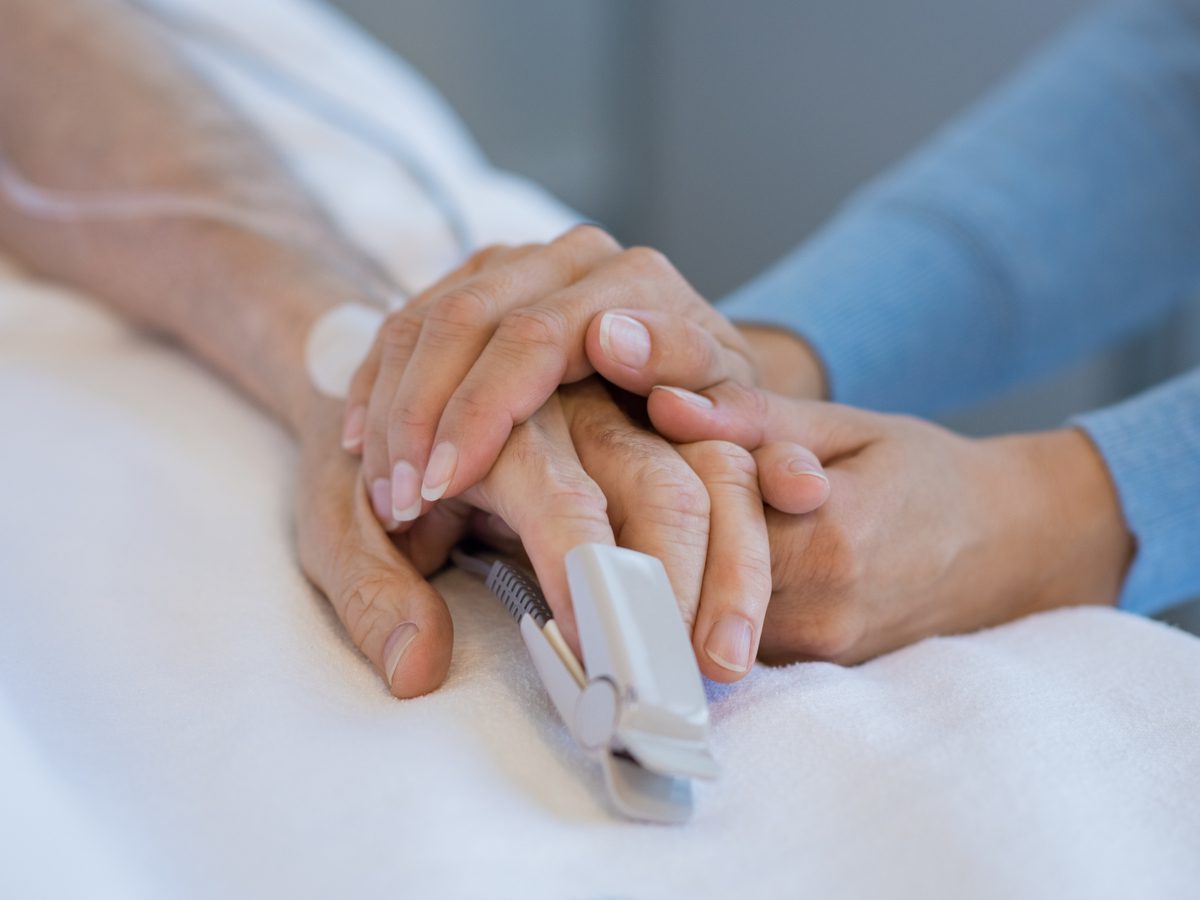
I am a stroke survivor
I stood in the bathroom doorway of our Vancouver Island home in November 2012, watching my wife, Pat, prepare to go out to lunch with friends. As I was admiring the woman I have loved for close to half a century, I started to feel a bit odd. Not nauseated or faint, simply odd. Perhaps a bit weak. Nothing that a brief lie-down wouldn’t cure.
After Pat left, I drifted to sleep. When I awoke two hours later, I made my way to my study, sat down at my computer, and noticed my right hand was sluggish. This was definitely strange. I had developed the habit of searching online for the peculiar things happening to my body as I got older, so I typed “stroke” into Google. I can’t say why I typed that and not “flu” or “Lyme disease” or “heart attack.”
I found the common symptoms: sudden numbness or confusion, trouble with vision or walking, dizziness or severe headache. I also found several tests: Can you raise your arms? Can you smile?
I lifted my arms above my head. I smiled. So I told myself, You’re not having a stroke. Still feeling tired, I went back to bed. I had the flu. That was it.
At about 4 p.m., Pat came home. “You’re still in bed!” she remarked.
Another hour passed, and I continued to feel off. Finally, Pat insisted we head for the hospital. By the time we were shown to an exam room, I was anxious to put an end to all of this nonsense. While I was retired from academia, I still edited manuscripts and wrote books. I had other, pressing things to do than worry about this mystery feeling.
The doctor asked for a detailed account of what had been happening. Then he performed a series of tests. He asked me to touch my nose and then follow his finger with my eyes. He told me to count backward by sevens. He had me squeeze his two fingers with each hand. He tested my reflexes. I passed every test, so I thought what I’d been experiencing was just a temporary malfunction of the wiring in my brain.
“I’d like to keep you in for observation,” the doctor said. My jaw dropped. “Didn’t I just pass your tests?”
“You might be having what we call a stuttering stroke,” he explained. “It happens over several hours, perhaps even several days. You’ve likely had a number of mini-strokes since this morning. If that’s the case, the likelihood of a larger stroke is very high.”
He told us someone would be along as soon as there was a free bed. Pat sat beside me working on a crossword puzzle while I squirmed in my seat. I remember trying to find a comfortable way to sit, something I suddenly found extremely hard to do.
Then the light started to disappear. Soon there would be none—a total absence. Of everything. “I’m dying,” I said. I was terrified.
Diagnosis confirmed
I could hear Pat calling for help as I slid to the floor. Then I was hoisted onto a stretcher and whisked into a treatment room, where staff inserted an IV and attached me to monitors. I could hear beeps and people assuring me I was in good hands.
“What is happening to me?” I asked. My voice sounded like an old phonograph record spinning too slowly. The words seemed heavy and thick.
The next thing I knew, my clothes were being removed. It was dawning on me that my movements were no longer voluntary. The lights dimmed. Pat kissed me on the forehead and departed. I was alone.
I remember nothing else about that night except being shunted back and forth through a fluorescent glare, never conscious of where I was going.
When Pat returned in the morning, she told me the doctors had confirmed that I had suffered a stroke. How severe it had been, no one knew yet. It would be another 36 hours before I was told that I might be paralyzed on one side of my body. Soon I would realize that not only could I not move, but when I attempted to form words, my vocal cords felt twisted.
In the afternoon of the second day, a woman came into my room and said I had been assigned to a bed on the acute-care ward. Pat packed up my belongings, and the porter rolled me past people shuffling along in nightgowns and patients in wheelchairs.
I was transferred from the stretcher to the bed, and a nurse told me, “If you need assistance, just press the buzzer on the pillow. Someone will come running.”
I don’t know what kind of magician she figured I was. I couldn’t reach the button, and even if I could, I lacked the strength to press it. I yearned to close my eyes. I could see that Pat was anxious to get home, but I think she feared she would be abandoning me. Finally, I said, “Go. Please. I need to sleep.”
When she returned mid-morning the next day, I woke up torn between panic and relief. Panic because the reality of what was happening was finally sinking in, and relief because my most reliable connection to the outside world was seated at my elbow.
Later, I saw a face peek around the curtain. Our daughter, Nicole. I wanted to embrace her, but all I could do was lie there. It’s unsettling to have your children see you vulnerable, and for a moment I felt desperate. She leaned over and kissed me. “Oh, Dad,” she said. “I’m so sorry.”
“Me, too,” I said, sounding like I was chewing on rubber bands.
Ready for rehab
That afternoon, a rehab doctor appeared at the end of my bed. At first, he told me, they’d thought my stroke was fairly mild. Nothing showed up on the CT scan. But a second scan revealed I’d had an ischemic stroke, an obstruction in a blood vessel, on the left side of my brain, resulting in the paralysis of my right extremities.
“What caused it?” I asked.
“We don’t know. I’d guess hypertension. Your blood pressure was very high. But you have other conditions that could have been contributing factors.”
Risk factors for stroke include high blood pressure, diabetes, high cholesterol, sleep apnea and being overweight. I qualified on all fronts.
“The good news,” the doctor said, “is that a bed has become available in rehab. You’ll be put on a six-to-eight-week intensive course, followed by eight weeks as an outpatient. You need to be willing to work hard. What do you think?”
“Yes, I can do it,” I answered, although at the moment my body suggested otherwise. “Count me in.”
The next morning, Pat and Nicole were both there when three physiotherapists arrived to take me for a walk. With one swift movement, they had me perched on the side of the bed. “We’ll walk as far as Nicole, okay?”
I shuffled, my left foot lifting, my right foot dragging behind. I walked a distance of only 20 feet, but Nicole seemed excited and applauded. “Oh, Dad,” she said. “You did it. I’m so proud of you!”
“Congratulations,” the therapists chimed in. “You’re ready for therapy.”
Relearn and recover
My first night in the rehab ward was terrifying. I knew I was in an area of the hospital where recovery is considered a matter of luck or chance. The gravity of my condition became fully apparent. Through the night, I wept.
Thankfully, neither Pat nor the staff would let me feel sorry for myself—even when I was frustrated and ready to give up. My first day of rehab, I had an appointment in the gym. “Do you know the way?” one of the nurses asked. I realized they expected me to wheel myself there. Good luck, I thought. I couldn’t move in a straight line. My right arm hung lifeless in my lap, and when I pulled with my left hand, I did doughnuts, spinning in circles.
“Drag your left foot along the ground as you push,” a nurse advised. When I tried, I made it a few yards before I veered right and smashed into the wall. “Perseverance,” she called to me.
To my surprise, after a few more collisions, I bolted in a straight line toward the gym.
To regain movement on my damaged side, I practised “mirror therapy.” The goal is to fool the brain. A mirror was placed on a table by my right shoulder, my right arm extended behind the mirror. Then with my good hand, I performed several simple exercises, staring in the mirror as hard as I could.
I drummed my fingers, formed a fist, flexed the fingers of my left hand. I did this slowly so my brain could take in the movement, pausing and then repeating, for about a half hour.
What I saw, of course, was the reverse image. I thought I was looking at my right hand doing the movements. My brain was being fooled, and I was happy to embrace this deception.
One day, after a few weeks, Nicole was sitting opposite me as I did this exercise, and she jumped to her feet. She shouted that my damaged hand had mimicked the movement of my good hand. At first, I didn’t believe her, but then I lifted my paralyzed arm and, much to my amazement, flung it in a circle, hitting the mirror. I let out a whoop. I had movement in my arm for the first time since the day of the stroke!
Going home
The week before Christmas, five weeks after my stroke, the rehab doctor came to see me. By then, I was able to stand on my own. I had started to climb the stairs in the gym, hanging on to the railing. I could pedal the stationary bike for 15 minutes. Sure, I sometimes became morose, but I had taken a vow: to remain positive, to recover.
The doctor asked me if I wanted to go home for Christmas, then return in the New Year as an outpatient for three months. I was both elated and scared.
I spent most of Christmas Day sleeping. Nicole arrived the next day with her partner, Iain, and their daughter, Flora. As soon as my three-year-old granddaughter saw me, she frowned—what happened to Poppa? But she was intrigued by my wheelchair.
As they were leaving the following morning, Flora said, “Poppa, please get better.”
A year would pass before she felt confident enough to approach me and wrap her arms around my legs. By then I was walking with a cane.
My weeks of outpatient therapy were monotonous, but the benefits were immeasurable. I pedalled a stationary bike, climbed steps, and did leg lifts, squats and arm pulls. I was finally able to pronounce a word without confusing the vowels and consonants.
Throughout, my emotional control was fragile. I would weep when I saw scenes of poverty on TV. The silliest jokes could cause unstoppable giggles.
I’ve learned that stroke recovery is unpredictable. The old notion that there is a finite window in which to achieve rehabilitation is simply false. It’s unlikely I’ll return to being the person I once was, physically or mentally. But I’m confident I can continue to repair and rebuild, and find a place for myself in my reconfigured world where I feel both valuable and valued.
There is nothing smooth about stroke recovery, but there’s also no limit.
From the book The Defiant Mind by Ron Smith. Copyright © 2016 by Ron Smith, ronsdalepress.com.
Next, learn about the common health symptoms you should never ignore.

Reader’s Digest Canada: The 2019 fire season in Canada was, relatively speaking, a quiet one—at least in B.C. Might that be a good sign for this year?
Karen Hodges: Unfortunately, no. To make predictions on the coming fire season, forecasters look at things like available fuel (dead wood), snowfall in the winter and how quickly it gets hot in the spring. These factors vary annually, so while it’s true that last year was less dramatic in Canada, that doesn’t mean anything for this summer.
However, when it comes to longer-term patterns, if you look at the last 50 years in Canada and around the world, we’re seeing a greater number of fires, and they’re more severe. Mega fires—the ones that burn more than 10,000 hectares—used to be the exception, but that is no longer the case.
Why is that?
The most significant factor is climate change. The kind of prolonged hot weather we’re now seeing creates the flammable conditions—dry vegetation and soil—in which fires can thrive. Also, the vast majority of naturally started fires are caused by lightning storms, which increase in higher temperatures.
What are some common causes of blazes started by us?
The most frequent ones are sparks from power tools, improperly discarded cigarette butts and leaving a campfire burning. Then there is the fact that more humans are living in parts of nature where they didn’t before. The wildfires in California are a good example of that—new homes there are surrounded by extremely flammable conditions.
Is that nature’s way of telling humans to stand down?
Well, no, but it is an example of the challenges of balancing our activity with the will of Mother Nature. In North America we have this misconception that all fires need to be fought, when in fact fires play an important role in regeneration for most ecosystems. A few decades of fire suppression has fostered thicker forest growth, more trees and, therefore, more connected fuel. So now, if a fire starts anywhere it’s going to burn through everything. This is another key factor in why large wildfires are the new norm.
How can I prepare if I’m heading out into the bush this summer?
Carry water and a shovel so that if something does spark, you’d have a chance of putting it out. Have an alternative exit plan, particularly if you’re camping at a dead end. The other thing—and this can be hard because a lot of people seek out nature to unplug—is that it’s a good idea to bring a cell phone or radio so that you have a way of learning about any impending danger.
Any other dangers to be aware of?
Smoke is a big problem because it carries super-fine particulates (soot and gases) that are hard for our lungs to clear. These days, we are witnessing a lot of smoke that persists in regions for months—and travels the planet. I live in Kelowna, and there were weeks in 2017 and 2018 when our air was worse than that of New Delhi and Shanghai.
I heard smoke from the B.C. fires made it all the way to New York City.
I believe it. In B.C. we got a bunch of Siberian smoke. We’re talking hundreds to thousands of kilometres.
Next, read our expert interview answering the question: what can I really do about the climate crisis?
When my husband Allan reached a certain age and was contemplating retirement, I was worried about how he would keep himself busy, as he is the type who needs to be active. After visiting a friend who is into collecting phonographs, Allan became interested and the rest is history.
He joined the Canadian Antique Phonograph Society (CAPS) in 2011 and his collection of phonographs continues to grow. He loves scouring garage sales, flea markets and auctions—anywhere he might be able to find and salvage a machine that is destined for a landfill due to its sad state of disrepair.
Allan spends a lot of time taking the old machines apart, refinishing the wood on the cabinets and bringing them back to their original state.
One part of the restoration that is particularly time-consuming is repairing the wind-up mechanism. Luckily, he has a good friend from CAPS known as the “gramophone doctor,” who supplies many of the original parts and services the motors.
Over the years, Allan has managed to restore more than 50 phonographs. Just recently, he restored an Edison Diamond Disc phonograph, as well as a tabletop model for a museum in Osoyoos, British Columbia. Allan has also donated some phonographs to various museums in our area, and given others as prizes for fundraisers.
At the moment, he probably has about 30 machines on display. He also has an extensive collection of vinyl records including 78s, 45s, Diamond Disc records and Edison cylinder records.
Allan finds it very rewarding to bring these phonographs back to life for people to once again enjoy and appreciate.
Next, take a peek at this incredible Blue Mountain pottery collection.


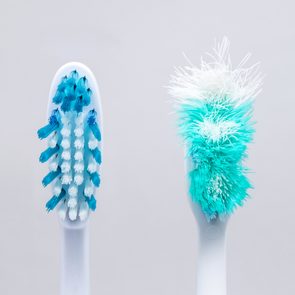














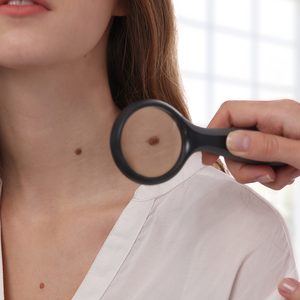
 Collecting Wolf Originals Soapstone" width="295" height="295" />
Collecting Wolf Originals Soapstone" width="295" height="295" />